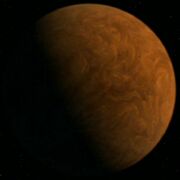m (Robot-assisted disambiguation: List of races and cultures) |
(Adding real tech. I think I've also heard this articulated in passing on TNG . . .) |
||
| Line 3: | Line 3: | ||
Gas giants serve little purpose to the [[Federation]] or other [[Races and cultures|star-faring races]], as they have little in resources that can be readily harvested and are nearly impossible to [[colony|colonize]] due to their lack of a solid surface. Although many suggestions for mining them have been put forward over the years, there are still few [[Races and cultures|races]] that attempt to harvest raw materials from gas giants, because the process is both dangerous and unnecessary (given the abundance of solid-cored planets providing sufficient raw materials). |
Gas giants serve little purpose to the [[Federation]] or other [[Races and cultures|star-faring races]], as they have little in resources that can be readily harvested and are nearly impossible to [[colony|colonize]] due to their lack of a solid surface. Although many suggestions for mining them have been put forward over the years, there are still few [[Races and cultures|races]] that attempt to harvest raw materials from gas giants, because the process is both dangerous and unnecessary (given the abundance of solid-cored planets providing sufficient raw materials). |
||
| + | |||
| + | It is, however, believed that the presence of one or more gas giants will help life-bearing planets in the same system to develop. This is because their large gravitational pull tends to remove planetoids, asteroids and other objects which might otherwise pose a hazard to life forms on smaller worlds. |
||
In [[Starfleet]]'s [[planetary classification]], gas giants are [[class J planet]]s, ranging in age from 2 to 10 billion years. The diameter of a gas giant ranges from 50,000 km to 140,000 km, and its [[atmosphere]] is layered with various gases, at different densities and temperatures. Gas giants usually lie in the cold zone of a [[star]]'s ecosphere, and have been known to host [[hydrocarbon]]-based indiginous [[lifeform]]s. |
In [[Starfleet]]'s [[planetary classification]], gas giants are [[class J planet]]s, ranging in age from 2 to 10 billion years. The diameter of a gas giant ranges from 50,000 km to 140,000 km, and its [[atmosphere]] is layered with various gases, at different densities and temperatures. Gas giants usually lie in the cold zone of a [[star]]'s ecosphere, and have been known to host [[hydrocarbon]]-based indiginous [[lifeform]]s. |
||
Revision as of 10:52, 9 September 2006

A gas giant
A gas giant is a huge planet made entirely of base gases, though they often possess solid cores. Gas giants are generally made of the same materials as stars, but lack the mass necessary to begin nuclear fusion. Jupiter and Saturn in the Sol system are examples of gas giants. Jupiter was the first gas giant discovered by humans, although its true nature wasn't learned until centuries later.
Gas giants serve little purpose to the Federation or other star-faring races, as they have little in resources that can be readily harvested and are nearly impossible to colonize due to their lack of a solid surface. Although many suggestions for mining them have been put forward over the years, there are still few races that attempt to harvest raw materials from gas giants, because the process is both dangerous and unnecessary (given the abundance of solid-cored planets providing sufficient raw materials).
It is, however, believed that the presence of one or more gas giants will help life-bearing planets in the same system to develop. This is because their large gravitational pull tends to remove planetoids, asteroids and other objects which might otherwise pose a hazard to life forms on smaller worlds.
In Starfleet's planetary classification, gas giants are class J planets, ranging in age from 2 to 10 billion years. The diameter of a gas giant ranges from 50,000 km to 140,000 km, and its atmosphere is layered with various gases, at different densities and temperatures. Gas giants usually lie in the cold zone of a star's ecosphere, and have been known to host hydrocarbon-based indiginous lifeforms.
References
- ENT:
- "Broken Bow"
- "Sleeping Dogs"
- "Marauders"
- "Dawn"
- "Judgement"
- "Horizon"
- "Hatchery"
- "Azati Prime"
- "In a Mirror, Darkly, Part I"
- TNG:
- "Ship in a Bottle"
- "Interface"
- DS9:
